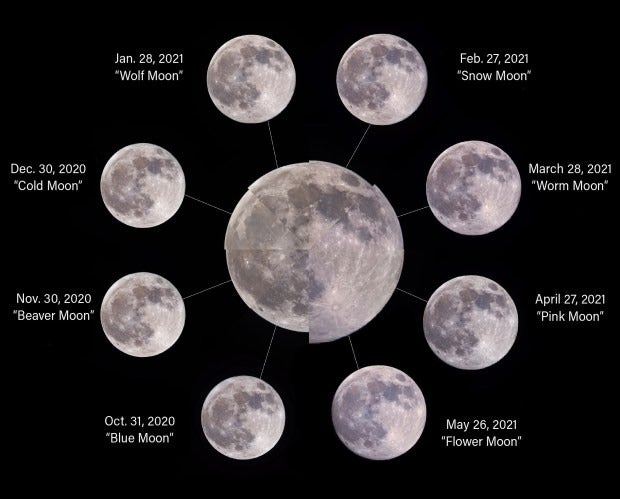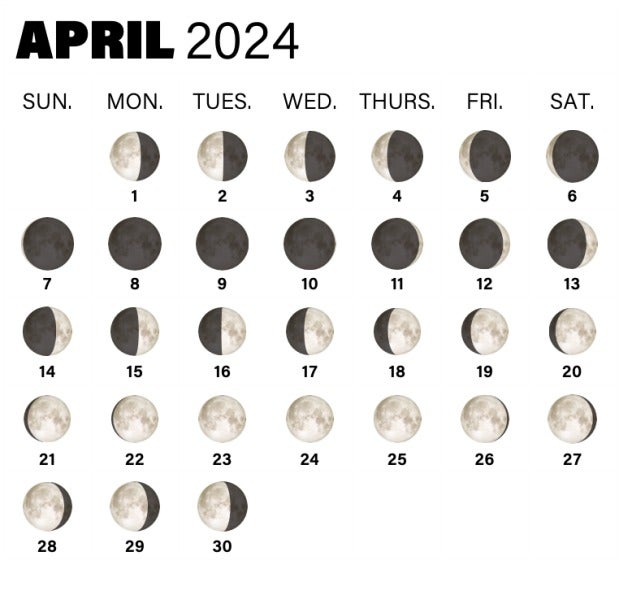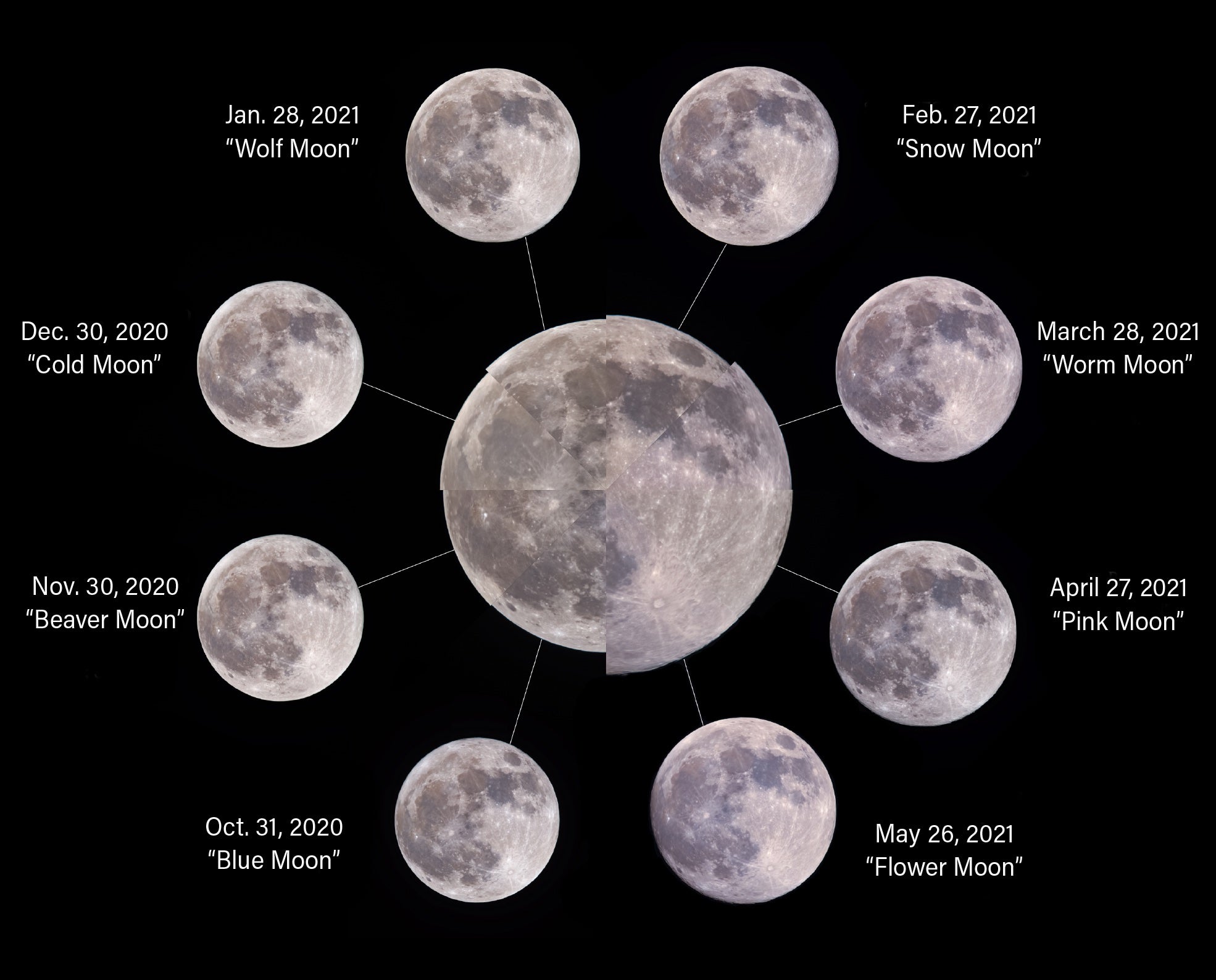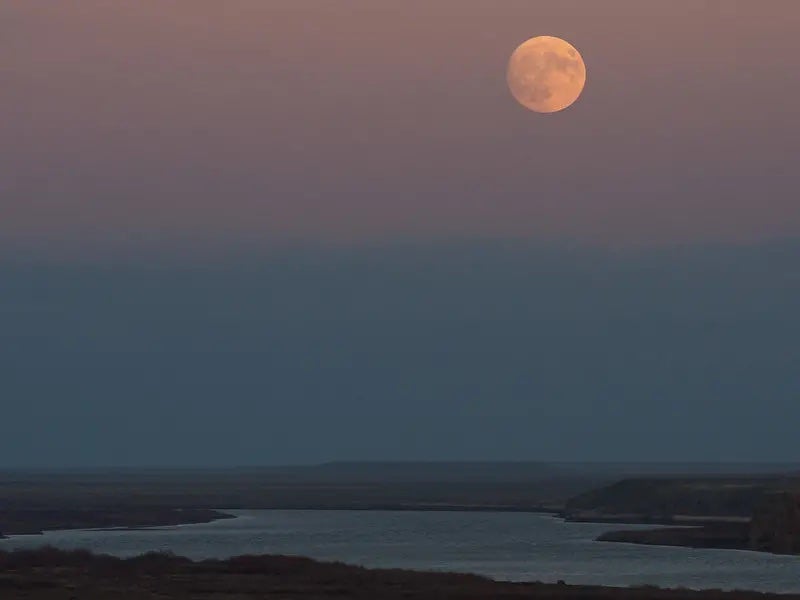
A composite image showing the Full Moons in 2020 and 2021 by month. Credit: Soumyadeep Mukherjee.
The phenomenon of a Full Moon arises when our planet, Earth, is precisely sandwiched between the Sun and the Moon. This alignment ensures the entire side of the Moon that faces us gleams under sunlight. And thanks to the Moon’s orbit around Earth, the angle of sunlight hitting the lunar surface and being reflected back to our planet changes, giving birth to varied lunar phases.
We’ll update this article multiple times each week with the latest moonrise, moonset, Full Moon schedule, and some of what you can see in the sky each week.
The Full Moon in April 2024 was at 7:49 p.m. ET on Tuesday, April 23, and is called the Pink Moon.
The Full Moon in May 2024 is the Flower Moon and that will happen at 9:53 a.m. on Thursday, May 23.
Here’s the complete list of Full Moons this year and their traditional names.
2024 Full Moon schedule and names of each
(all times Eastern)
- Jan. 25 — 12:54 p.m. — Wolf Moon 🐺
- Feb. 24 —7:30 a.m. — Snow Moon ❄️
- March 25 — 3 a.m. — Worm Moon 🪱
- April 23 — 7:49 p.m. — Pink Moon 🎀
- May 23 — 9:53 a.m. — Flower Moon 🌷
- June 21 — 9:08 p.m. — Strawberry Moon 🍓
- July 21 — 6:17 a.m. — Buck Moon 🦌
- Aug. 19 — 2:26 p.m. — Sturgeon Moon 🐟
- Sept. 17 — 10:34 p.m. — Corn Moon 🌽
- Oct. 17 — 7:26 a.m. — Hunter’s Moon 🏹
- Nov. 15 — 4:28 p.m. — Beaver Moon 🦫
- Dec. 15 — 4:02 a.m. — Cold Moon 🥶
The phases of the Moon in April 2024
These images below show the day-by-day phases of the moon this month. The Full Moon in April was on April 23.

The moonrise and moonset schedule this week
The following is adapted from Alison Klesman’s The Sky This Week article, which you can find here.
*Times for sunrise, sunset, moonrise, and moonset are given in local time from 40° N 90° W. The Moon’s illumination is given at 12 P.M. local time from the same location.
Saturday, April 27
With the Moon rising just before midnight, there are again several hours of dark-sky viewing available after sunset. Let’s seek out the Ghost of Jupiter, often considered one of the springtime sky’s premier planetary nebulae. It’s also cataloged as NGC 3242.
Planetary nebulae consist of gas and dust blown off by aging red giant stars; as these stars evolve into white dwarfs, the debris remains, lit up by the white-hot remnant within for a short time. Planetary nebulae are fleeting, only lasting some 10,000 to 20,000 years before fading away.
The Ghost of Jupiter is so named because it spans roughly the same size as the gas giant planet in our sky: about 16″ in diameter. Its compact, spherical shape combined with its magnitude of 7.8 make it relatively bright and easy to observe. To most observers, and particularly in larger scopes, it looks distinctly blue-green.
The nebula is located in Hydra, which sits in the south an hour or two after sunset. You can find the Ghost of Jupiter by looking about 6.5° west-southwest of 3rd-magnitude 4 Crateris in nearby Crater the Cup.
Sunrise: 6:04 A.M.
Sunset: 7:52 P.M.
Moonrise: 11:06 P.M.
Moonset: 8:00 AM
Moon Phase: Waning gibbous (86%)
Sunday, April 28
Mars passes 0.04° south of Neptune at midnight EDT. Neither is visible at that time, as they rise a short time before sunrise — so tune in tomorrow, when we’ll catch them in the early-morning sky on Monday.
Tonight, let’s instead focus on the northern constellation Camelopardalis, which lies to the left of the North Star this evening. (Camelopardalis is a circumpolar constellation, meaning it appears to rotate around the North Star from northern locations, rather than rising in the east and setting in the west.)
Let’s first look for NGC 1502, a 6th-magnitude open cluster about 9° south of magnitude 4.6 Gamma (γ) Camelopardalis. This beautiful ball-shaped grouping of young stars is readily visible in binoculars as a soft glow, while telescopes will begin to pull out individual members as points of light.
NGC 1502 forms the “base” of a famous asterism called Kemble’s Cascade, which resembles a flow of water cascading down into a pool. The star cluster is often envisioned as the spray at the end of the line. From NGC 1502, you can trace the rest of the Cascade “backwards” to the source along 14 or so 7th- to 9th-magnitude stars to the northwest. NGC 1502 sits at the southeast end of the Cascade, which stretches about 2.5° in total.
Sunrise: 6:03 A.M.
Sunset: 7:53 P.M.
Moonrise: 12:11 A.M.
Moonset: 8:53 A.M.
Moon Phase: Waning gibbous (79%)
Monday, April 29
Sunrise: 6:02 A.M.
Sunset: 7:54 P.M.
Moonrise: 1:08 A.M.
Moonset: 9:56 A.M.
Moon Phase: Waning gibbous (69%)
Tuesday, April 30
Sunrise: 6:01 A.M.
Sunset: 7:55 P.M.
Moonrise: 1:56 A.M.
Moonset: 11:06 A.M.
Moon Phase: Waning gibbous (59%)
Wednesday, May 1
The Moon reaches Last Quarter at 7:27 A.M. EDT this morning. This lunar phase occurs when the Moon rises after midnight and lingers in the early-morning sky, offering early risers a chance to view our satellite before and after sunrise (though take extreme care when observing through optics after the Sun clears the horizon). Clearly visible now is the western portion of the nearside, dominated by Mare Imbrium and Oceanus Procellarum.
Sunrise: 5:59 A.M.
Sunset: 7:56 P.M.
Moonrise: 2:36 A.M.
Moonset: 12:20 P.M.
Moon Phase: Waning crescent (48%)
Thursday, May 2
Sunrise: 5:58 A.M.
Sunset: 7:56 P.M.
Moonrise: 3:09 A.M.
Moonset: 1:36 P.M.
Moon Phase: Waning crescent (36%)
Friday, May 3
Sunrise: 5:57 A.M.
Sunset: 7:57 P.M.
Moonrise: 3:37 A.M.
Moonset: 2:50 P.M.
Moon Phase: Waning crescent (26%)
The phases of the Moon
The phases of the Moon are: New Moon, waxing crescent, First Quarter, waxing gibbous, Full Moon, waning gibbous, Last Quarter, and waning crescent. A cycle starting from one Full Moon to its next counterpart, termed the synodic month or lunar month, lasts about 29.5 days.
Though a Full Moon only occurs during the exact moment when Earth, Moon, and Sun form a perfect alignment, to our eyes, the Moon seems Full for around three days.
Different names for different types of Full Moon
There are a wide variety of specialized names used to identify distinct types or timings of Full Moons. These names primarily trace back to a blend of cultural, agricultural, and natural observations about the Moon, aimed at allowing humans to not only predict seasonal changes, but also track the passage of time.
For instance, almost every month’s Full Moon boasts a name sourced from Native American, Colonial American, or other North American traditions, with their titles mirroring seasonal shifts and nature’s events.

Wolf Moon (January): Inspired by the cries of hungry wolves.
Snow Moon (February): A nod to the month’s often heavy snowfall.
Worm Moon (March): Named after the earthworms that signal thawing grounds.
Pink Moon (April): In honor of the blossoming pink wildflowers.
Flower Moon (May): Celebrating the bloom of flowers.
Strawberry Moon (June): Marks the prime strawberry harvest season.
Buck Moon (July): Recognizing the new antlers on bucks.
Sturgeon Moon (August): Named after the abundant sturgeon fish.
Corn Moon (September): Signifying the corn harvesting period.
Hunter’s Moon (October): Commemorating the hunting season preceding winter.
Beaver Moon (November): Reflects the time when beavers are busy building their winter dams.
Cold Moon (December): Evocative of winter’s chill.
In addition, there are a few additional names for Full Moons that commonly make their way into public conversations and news.
Super Moon: This term is reserved for a Full Moon that aligns with the lunar perigee, which is the Moon’s nearest point to Earth in its orbit. This proximity renders the Full Moon unusually large and luminous. For a Full Moon to earn the Super Moon tag, it should be within approximately 90 percent of its closest distance to Earth.
Blue Moon: A Blue Moon is the second Full Moon in a month that experiences two Full Moons. This phenomenon graces our skies roughly every 2.7 years. Though the term suggests a color, Blue Moons aren’t truly blue. Very occasionally, atmospheric conditions such as recent volcanic eruptions might lend the Moon a slightly blueish tint, but this hue isn’t tied to the term.
Harvest Moon: Occurring closest to the autumnal equinox, typically in September, the Harvest Moon is often renowned for a distinct orange tint it might display. This Full Moon rises close to sunset and sets near sunrise, providing extended hours of bright moonlight. Historically, this was invaluable to farmers gathering their produce.
Common questions about Full Moons

What is the difference between a Full Moon and a New Moon? A Full Moon is witnessed when Earth lies between the Sun and the Moon, making the entire Moon’s face visible. Conversely, during a New Moon, the Moon lies between Earth and the Sun, shrouding its Earth-facing side in darkness.
How does the Full Moon influence tides? The Moon’s gravitational tug causes Earth’s waters to bulge, birthing tides. During both Full and New Moons, the Sun, Earth, and Moon are in alignment, generating “spring tides.” These tides can swing exceptionally high or low due to the combined gravitational influences of the Sun and Moon.
Do Full Moons have an impact on human behavior? While numerous tales suggest Full Moons stir human behavior, causing increased restlessness or even lunacy, rigorous scientific analyses have largely debunked these tales.
Full Moons, in their myriad forms, stand testament to humanity’s enduring captivation with the cosmos. They evoke not just our celestial connection but also tether us to Earth’s rhythms. Whether you’re an avid stargazer or an occasional night sky admirer, Full Moons invariably call for our attention, inviting both introspection and marvel.
Here are the dates for all the lunar phases in 2024:
| New | First Quarter | Full | Last Quarter |
|---|---|---|---|
| Jan. 3 | |||
| Jan. 11 | Jan. 17 | Jan. 25 | Feb. 2 |
| Feb. 9 | Feb. 16 | Feb. 24 | March 3 |
| March 10 | March 17 | March 25 | April 1 |
| April 8 | April 15 | April 23 | May 1 |
| May 7 | May 15 | May 23 | May 30 |
| June 6 | June 14 | June 21 | June 28 |
| July 5 | July 13 | July 21 | July 27 |
| Aug. 4 | Aug. 12 | Aug. 19 | Aug 26 |
| Sept. 2 | Sept. 11 | Sept. 17 | Sept. 24 |
| Oct. 2 | Oct. 10 | Oct. 17 | Oct. 24 |
| Nov. 1 | Nov. 9 | Nov. 15 | Nov. 22 |
| Dec. 1 | Dec. 8 | Dec. 15 | Dec. 22 |
| Dec. 30 |

